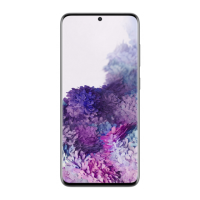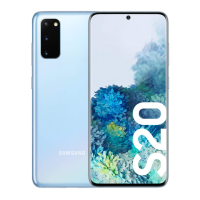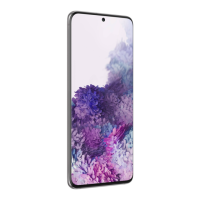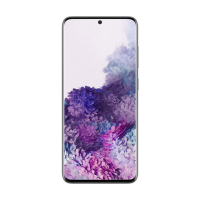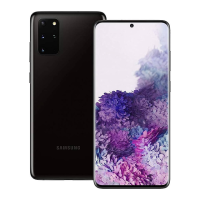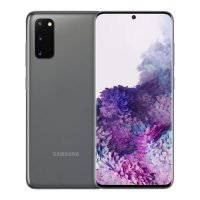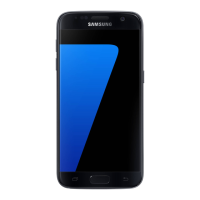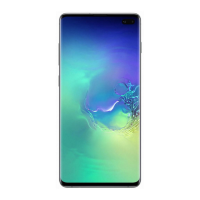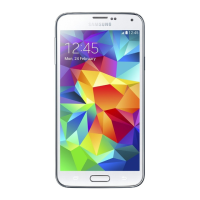Do you have a question about the Samsung SM-G988B and is the answer not in the manual?
Essential pre-use information for safe device operation.
Guidelines for preserving the device's water and dust resistance features.
Addresses device overheating causes and provides resolution steps.
Identifies and explains the device's physical components and their roles.
Covers charging, power saving, and battery health management for extended usage.
Instructions for installing, removing, and managing SIM/USIM cards.
Guidance on memory card installation, formatting, and removal.
Procedures for powering the device on, off, and performing a restart.
Step-by-step instructions for setting up the device for the first time.
Information on creating, signing into, and utilizing a Samsung account.
Explains basic touchscreen interactions like tapping, swiping, and gestures.
Customization options for the lock screen, including security and notifications.
Details on keyboard layout, input methods, and text entry functionalities.
How to download, install, and remove applications from the device.
Guides on uninstalling, disabling, and managing app permissions.
Introduction to Bixby's AI assistant features and usage.
Explores Bixby Vision for image recognition and information retrieval.
Personalizing content and recommendations using Bixby Home.
Creating and managing reminders with time or location-based notifications.
Functions for making and receiving calls, managing contacts, and call logs.
Managing contact information, adding, importing, and sharing contacts.
Sending, viewing, and blocking messages, including notification settings.
Browsing the web, using secret mode, and managing browser features.
Comprehensive guide to camera modes, settings, shooting photos, and recording videos.
Viewing, editing, and organizing photos and videos stored on the device.
Creating and using personalized emojis and stickers with the camera.
Customizing the display of information when the screen is off.
Utilizing edge panels for quick access to apps and features.
Running multiple applications simultaneously in split-screen or pop-up views.
Secure mobile payment service setup and usage.
Managing health and fitness goals, tracking activities, and social features.
Measuring object size and distance using the camera.
Connecting and managing wearable devices.
Accessing support, feedback, and community features.
Creating and managing notes with rich media.
Managing schedules, events, and reminders.
Recording voice memos and converting speech to text.
Managing files stored on the device and in cloud services.
Utilizing alarm, stopwatch, timer, and world clock functions.
Organizing and launching games for an enhanced gaming experience.
Improving gaming performance and environment.
Providing a safe digital environment for children with parental controls.
Connecting and controlling smart devices and home appliances.
Sharing various content types using multiple methods.
Using the smartphone as a desktop computer experience.
Overview of essential Google applications for productivity and entertainment.
Managing network and wireless connections like Wi-Fi and Bluetooth.
Connecting to Wi-Fi networks and using Wi-Fi Direct for direct device connections.
Pairing and communicating with Bluetooth-enabled devices.
Utilizing NFC for contactless transactions and information reading.
Optimizing mobile data usage by controlling background app activity.
Managing multiple SIM cards for calls, texts, and data.
Sharing the device's mobile data connection with other devices.
Advanced settings for printing, MirrorLink, and download booster.
Customizing audio and vibration feedback for alerts and calls.
Managing how and when notifications are displayed and alerted.
Adjusting screen brightness, color, resolution, and appearance settings.
Applying a dark theme to reduce eye strain and enhance night viewing.
Configuring security, shortcuts, and display options for the locked screen.
Enhancing device security with face recognition, fingerprints, and secure data storage.
Managing login information, personal details, and payment cards using biometric data.
Creating a protected space for private content and applications.
Managing user accounts and backing up device data to cloud or computers.
Enabling and configuring device-specific functionalities and customizations.
Using device movements and gestures for interaction and shortcuts.
Monitoring and managing device usage for personal and child safety.
Optimizing device performance, battery, storage, and security.
System settings for language, date, time, and device reset.
Enhancing device usability through various accessibility features.
Adjusting sound settings for hearing aid compatibility and sound detection.
Controlling the device using alternative input methods like gestures and switches.
Guidance on resolving common device problems and error messages.
Safety instructions for battery removal by authorized service personnel.
Information on Specific Absorption Rate (SAR) and FCC RF exposure guidelines.
Guidelines for device compatibility with hearing aids and interference ratings.
Compliance statements regarding FCC rules and radio frequency interference.
Important warnings about device operation, accessories, and handling.
List of registered trademarks and copyrights associated with the device.
Essential pre-use information for safe device operation.
Guidelines for preserving the device's water and dust resistance features.
Addresses device overheating causes and provides resolution steps.
Identifies and explains the device's physical components and their roles.
Covers charging, power saving, and battery health management for extended usage.
Instructions for installing, removing, and managing SIM/USIM cards.
Guidance on memory card installation, formatting, and removal.
Procedures for powering the device on, off, and performing a restart.
Step-by-step instructions for setting up the device for the first time.
Information on creating, signing into, and utilizing a Samsung account.
Explains basic touchscreen interactions like tapping, swiping, and gestures.
Customization options for the lock screen, including security and notifications.
Details on keyboard layout, input methods, and text entry functionalities.
How to download, install, and remove applications from the device.
Guides on uninstalling, disabling, and managing app permissions.
Introduction to Bixby's AI assistant features and usage.
Explores Bixby Vision for image recognition and information retrieval.
Personalizing content and recommendations using Bixby Home.
Creating and managing reminders with time or location-based notifications.
Functions for making and receiving calls, managing contacts, and call logs.
Managing contact information, adding, importing, and sharing contacts.
Sending, viewing, and blocking messages, including notification settings.
Browsing the web, using secret mode, and managing browser features.
Comprehensive guide to camera modes, settings, shooting photos, and recording videos.
Viewing, editing, and organizing photos and videos stored on the device.
Creating and using personalized emojis and stickers with the camera.
Customizing the display of information when the screen is off.
Utilizing edge panels for quick access to apps and features.
Running multiple applications simultaneously in split-screen or pop-up views.
Secure mobile payment service setup and usage.
Managing health and fitness goals, tracking activities, and social features.
Measuring object size and distance using the camera.
Connecting and managing wearable devices.
Accessing support, feedback, and community features.
Creating and managing notes with rich media.
Managing schedules, events, and reminders.
Recording voice memos and converting speech to text.
Managing files stored on the device and in cloud services.
Utilizing alarm, stopwatch, timer, and world clock functions.
Organizing and launching games for an enhanced gaming experience.
Improving gaming performance and environment.
Providing a safe digital environment for children with parental controls.
Connecting and controlling smart devices and home appliances.
Sharing various content types using multiple methods.
Using the smartphone as a desktop computer experience.
Overview of essential Google applications for productivity and entertainment.
Managing network and wireless connections like Wi-Fi and Bluetooth.
Connecting to Wi-Fi networks and using Wi-Fi Direct for direct device connections.
Pairing and communicating with Bluetooth-enabled devices.
Utilizing NFC for contactless transactions and information reading.
Optimizing mobile data usage by controlling background app activity.
Managing multiple SIM cards for calls, texts, and data.
Sharing the device's mobile data connection with other devices.
Advanced settings for printing, MirrorLink, and download booster.
Customizing audio and vibration feedback for alerts and calls.
Managing how and when notifications are displayed and alerted.
Adjusting screen brightness, color, resolution, and appearance settings.
Applying a dark theme to reduce eye strain and enhance night viewing.
Configuring security, shortcuts, and display options for the locked screen.
Enhancing device security with face recognition, fingerprints, and secure data storage.
Managing login information, personal details, and payment cards using biometric data.
Creating a protected space for private content and applications.
Managing user accounts and backing up device data to cloud or computers.
Enabling and configuring device-specific functionalities and customizations.
Using device movements and gestures for interaction and shortcuts.
Monitoring and managing device usage for personal and child safety.
Optimizing device performance, battery, storage, and security.
System settings for language, date, time, and device reset.
Enhancing device usability through various accessibility features.
Adjusting sound settings for hearing aid compatibility and sound detection.
Controlling the device using alternative input methods like gestures and switches.
Guidance on resolving common device problems and error messages.
Safety instructions for battery removal by authorized service personnel.
Information on Specific Absorption Rate (SAR) and FCC RF exposure guidelines.
Guidelines for device compatibility with hearing aids and interference ratings.
Compliance statements regarding FCC rules and radio frequency interference.
Important warnings about device operation, accessories, and handling.
List of registered trademarks and copyrights associated with the device.
| Model | SM-G988B |
|---|---|
| Category | Cell Phone |
| Network Technology | GSM / CDMA / HSPA / EVDO / LTE / 5G |
| Launch Date | 2020, February 11 |
| Status | Available. Released 2020, March 06 |
| Build | Glass front (Gorilla Glass 6), glass back (Gorilla Glass 6), aluminum frame |
| SIM | Single SIM (Nano-SIM) or Hybrid Dual SIM (Nano-SIM, dual stand-by) |
| Display Type | Dynamic AMOLED 2X, 120Hz, HDR10+, 1200 nits (peak) |
| Protection | Corning Gorilla Glass 6 |
| CPU | Octa-core (2x2.73 GHz Mongoose M5 & 2x2.50 GHz Cortex-A76 & 4x2.0 GHz Cortex-A55) |
| GPU | Mali-G77 MP11 |
| Memory Card slot | microSDXC (uses shared SIM slot) |
| RAM | 12GB |
| Main Camera Features | LED flash, auto-HDR, panorama |
| Main Camera Video | 8K@24fps, 4K@30/60fps, 1080p@30/60/240fps, 720p@960fps, HDR10+, stereo sound rec., gyro-EIS & OIS |
| Selfie Camera Features | Dual video call, Auto-HDR |
| Selfie Camera Video | 4K@30/60fps, 1080p@30fps |
| Loudspeaker | Yes, with stereo speakers |
| 3.5mm jack | No |
| WLAN | Wi-Fi 802.11 a/b/g/n/ac/6, dual-band, Wi-Fi Direct, hotspot |
| Bluetooth | 5.0, A2DP, LE |
| Positioning | GPS, GLONASS, BDS, GALILEO |
| NFC | Yes |
| Radio | FM radio (Snapdragon model only; market/operator dependent) |
| USB | USB Type-C 3.2, OTG |
| Sensors | Fingerprint (under display, ultrasonic), accelerometer, gyro, proximity, compass, barometer |
| Battery Type | Li-Ion 5000 mAh, non-removable |
| Water & Dust Resistance | IP68 dust/water resistant (up to 1.5m for 30 min) |
| Display Size | 6.9 inches |
| Display Resolution | 1440 x 3200 pixels |
| OS | Android 10, upgradable to Android 13, One UI 5 |
| Chipset | Exynos 990 (7 nm+) |
| Internal Memory | 128GB/256GB/512GB |
| Main Camera | 12 MP, f/2.2, 13mm (ultrawide), 1/2.55", 1.4µm, Super Steady video |
| Selfie Camera | 40 MP (wide) |
| Charging | 15W wireless (Qi/PMA) 4.5W reverse wireless |
| Colors | Cosmic Black |
